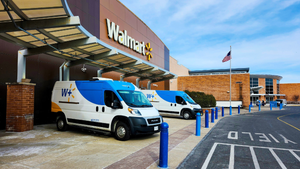'Rebound, Reboot, Reinvent': What retail and CPG companies can expect in a post-coronavirus world'Rebound, Reboot, Reinvent': What retail and CPG companies can expect in a post-coronavirus world
Nielsen study offers a vision of how the retail landscape and consumer shopping behavior will be changed

Among the many questions on the minds of retailers as we see an evolution of the coronavirus curve and a gradual opening up of other countries and parts of the United States are these: What will grocery retail and the CPG business look like in a post-COVID-19 environment? And will shoppers, whose behaviors have been altered so dramatically, return to pre-pandemic habits or is this new normal here to stay?

In a webinar on "Living Beyond COVID-19" presented by Nielsen on Thursday, Scott McKenzie (left), Nielsen Intelligence Leader, offered up three distinct time horizons for global market regeneration beyond the COVID-19 global health emergency and attached likely scenarios to each. The three-tiered framework identifies the conditions for businesses to “Rebound, Reboot or Reinvent” as they confront expected unprecedented recessionary conditions.
• Rebound: An early return to normal living conditions (schools, workplaces, stores, restaurants, etc., re-open) at some point in the third quarter of 2020.
• Reboot: A medium-term scenario that is positioned in the fourth quarter of the year.
• Reinvent: A longer-term view that places the world in a general return to normal living conditions at some point in the first half of 2021.
In each horizon identified by Nielsen, a different set of factors and respective consumer behaviors can be identified.
In horizon No. 1, “Rebound,” a series of health indicators, actions by governments and business, and market conditions point to a rebased “normal” that has some of the following as a societal response:

In horizon No. 2, “Reboot,” the societal response has a different set of focal points and positions the economy for meaningful regeneration toward the end of the year.

In horizon No. 3, “Reinvent,” as the name suggests, a complete reinvention is required and may not play out until the first half of 2021. The consumer behaviors and characteristics are sharply amplified compared to horizons No. 2 and No. 3.

With each of these time scenarios, McKenzie noted, the baskets of shoppers will also change. The repertoire, pack sizes, brand choices, product origins and more will be reconfigured as shoppers adjust to changed economic circumstances and a sharper focus on their health and safety.
Two clear sets of consumers will also emerge, according to Nielsen — those with insulated levels of spending, often those who have maintained employment and remain shielded from day-to-day economic impact and those who will be restrained in their spending habits due to unemployment, furloughing or other COVID-19-related challenges. (In April, unemployment in the United States hit 14.7% with 20.5 million jobs lost, according to Department of Labor figures.)
This polarization of spending is expected to drive new considerations for retailers and brands as they urgently examine the range of products being offered and the pricing dynamics within.
“The world is fundamentally recalibrating right now,” said McKenzie. “Consumer habits are changing at pace and understanding those changes, in the context of these scenarios, will be critical as businesses prioritize how they too recalibrate to meet the changed circumstances driven by COVID-19.”
One point that McKenzie stressed is that comparisons to the 2008 financial crisis and subsequent recession are not equivalent.
“Much has been made of comparisons to the 2008 global financial crisis, but this situation doesn’t make for accurate comparisons. The circumstances back then were fundamentally different,” he said. “Thousands weren’t dying each day, millions weren’t locked in their homes indefinitely, businesses weren’t ordered to close their doors, kids were still in school. The impact of this will be profound and more far reaching than anything we’ve seen in our lifetimes. The pace of change is also extraordinary.”
New shopping behaviors
McKenzie pointed to some new consumer behaviors that are being seen now and will likely escalate.
“Authenticating information is a good example,” he said. “More than ever in the products we buy, we want to know that they do the job they say they do. So efficacy is huge. If something is able to claim it kills 100% of gems in a cleaning product, for example. That’s good news for me as a consumer right now because that's what I'm looking for. I want easy authentication and understanding what I'm buying is going to do the right thing for me and my family.”

Consumers have also gravitated more to essential items versus nonessential items — and the need to do that in an environment that has limited touch points. As a consumer, McKenzie said, “I want more contactless experiences in my life. I want transactions that don't involve proximity to others if I can achieve that. I'm interested in hearing about things like zero-touch packaging or packaging that perhaps is resistant to disease. I also demand precaution around absolutely everything that I'm doing in my day. And I think we all live and feel that already and we can expect that to slowly amplify and it amplifies even more as you move into this reboot environment in quarter four.”
Brand choice and the emergence of private label will also be factors. Are consumers going to skew more to private label and what are they willing to pay?
“Right now, there's not a lot of price sensitivity in the market because people are just happy to be able to go to the store or online and get what they need,” McKenzie said. “But as the supply chain challenges and the fulfillment challenges that have been common in most markets around the world get rebalanced and supply is back, the shelves are full, then price will come back into play. What you're going to see are things like brand relationships changing. Consumers are perhaps trying brands or products in categories that they’ve never sampled before, sometimes because they were forced to due to an availability issue or perhaps because they’re seeking out something that offers more safety, more authentication, more health attributes and so they’re willing to try something different.”
McKenzie says the marketplace will be divided among two types of spenders, insulated and constrained. Insulated spenders are those have a job and health care and are perhaps spending less than normal spend because they’re in lockdown at home. They’re not spending on dry cleaning, restaurants, commuting and so on.
“So there are a lot of savings that are coming along,” he said. “So that means I've got some insulation in my life. I've got a confidence level around spending, at least in the short term that I'm still going to be able to afford most of the things that I need in my day.”
The constrained spender is someone who perhaps is one of the newly unemployed millions who are suddenly filing for unemployment or someone who's underemployed and is able to move in and out of employment — i.e., perhaps someone working in the restaurant industry, for example.
“I think one point of consistency between insulated and constrained spenders is that we expect health to continue to be as much as a priority as people can make it,” he said, “as they think about personal health care, the health of their families and what they can do to maintain that.”
Going hyperlocal
Over the past several years there has been a gravitation toward local buying for a number of reasons — perceived health benefits, environmental concerns, price. Expect that phenomenon — which McKenzie calls “buying milk from cows” — to continue to grow during and after COVID-19.
“There’s a real concern about products that might have crossed multiple borders that may have touched multiple sets of hands in this environment,” said McKenzie. “When people are looking for contactless experiences and guarantees of safety and hygiene along with the products they're buying, hence products that come from a shorter supply chain. And that’s even more focused as we move towards a re-invent stage to go hyperlocal.”
The affinity and trust that comes with local is something that retail chains and big brands are using, McKenzie said, but they're having to rethink that positioning that may already be in their wheelhouse, but that they've not really leveraged before as they thought about helping consumers understand that localness is something that they could take from them.
New tech demands
Technology is also playing a big role for COVID-19 exit strategies. McKenzie pointed to China as an example, where restrictions are being lifted and one of the things we’re seeing is a rise in smartphone upgrades from 2G to 3G with an eye toward 5G adoption.
Why? “Because with the bandwidth capacity that comes with 5G, that creates an environment that can allow things like virtual or augmented reality shopping experiences on your smart phone,” said McKenzie. “In China, there was also a real desire for drone delivery that we’re starting to see. We'd seen hints of this as recently as last year, when we'd asked consumers globally about their desire to have drug delivery. Now it's a reality here in the UK, for example, with a pharmacy group that's delivering via drone medicines to the elderly or those who are self-isolated. It’s a reality of course that comes with regulatory conditions, but certainly worth acknowledging as people demand contactless experiences.”

Technology will continue to be a critical factor. “This shift from brick-and-mortar to digital, those experiences need to get better and they need to get better faster as those shifts take place,” said McKenzie. “So that means retailers making bigger investments into their digital platforms, into their digital relationships with the people coming into their brick-and-mortar stores today who perhaps have shifted their shopping habits to online. So that reincorporation of the retail experience and the reimagination, which might be live or virtual reality or an augmented digital shopping experience, are just going to be extraordinarily critical. So being in listening mode and action mode at the same time just should be the new way of working, but at speeds we'd never worked at before.
“Retailers and manufacturers need to take a listening stance,” he added, “a listening stance that takes into account the technology demands that are coming from consumers.”
For our most up-to-date coverage, visit the coronavirus homepage.
About the Author
You May Also Like


.webp?width=300&auto=webp&quality=80&disable=upscale)



